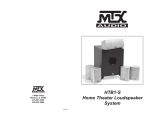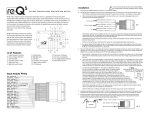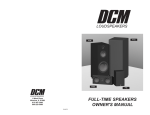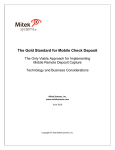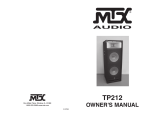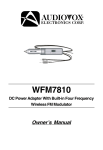Download MTX Audio MTX TP112 User's Manual
Transcript
SPECIFICATIONS- TP112 Diameter of Subwoofer (1) 12" Type Full Range Frequency Response 33Hz - 22kHz Nominal Impedance 8 Ohm Sensitivity (1w-1m) 92 dB Power Handling (Watts) 150 RMS/300 Peak Power Crossover Frequency 2.2 kHz Weight 37 lbs Dimensions 24.5"H x 14.65"W x 12.5"D Warranty Statement MTX TP112 purchased in the USA from an authorized MTX dealer are guaranteed against defects in material and workmanship for the period of five years from the date product is purchased by the end user. This warranty is limited to the original retail purchaser of product. Product found to be defective during that period will be repaired or replaced by MTX at no charge. This warranty is void if it is determined that unauthorized parties have attempted repairs or alterations of any nature. Warranty does not extend to cosmetics or finish. Before presuming a defect is present in the product, be certain that all related equipment and wiring is functioning properly. MTX disclaims any liability for other incurred damages resulting from product defects. Any expenses in the removal and reinstallation of products are not covered by this warranty. MTX's total liability will not exceed the purchase price of the product. If a defect is present, your authorized MTX dealer may be able to effect repairs. Proof of purchase is required when requesting service, so please retain your sales receipt and take a moment to register your warranty online at www.mtx.com TP112 One Mitek Plaza, Winslow, IL. 61089 1-800-225-5689 www.mtx.com 21A6965 OWNER'S MANUAL TP112 2-WAY SPEAKERS Congratulations on your purchase of an excellent, high performance loudspeaker system from MTX! We are confident that your purchase will bring you years of listening pleasure. MTX’s TP112 consists of a single 12” woofer matched with our X-radial designed horn loaded high frequency tweeter designed to provide uniform sound dispersion, and coverage area, with excellent sound quality. Your TP112 speaker is designed to perform equally well in many different applications, including low to mid level live sound reproduction, public address, karaoke applications, or mobile entertainment. The long excursion woofer and horn-loaded tweeter with high frequency protection circuitry make your TP112 suitable for voice or music. 1/4” Phone Jack Instead of using the speaker’s terminal posts, you can use the 1/4” phone jack to make the connection. If your amplifier has an 8 ohm phone jack, you can use speaker cable that has a phone plug on each end to connect the speaker’s 1/4" jack to the amps phone jack. Or, if your amplifier does not have an 8 ohm phone jack, you can use speaker wire that has a phone plug on one end to connect your speakers 1/4" jack, and stripped ends to connect to your amplifiers output terminals. Your speakers carrying handles, mounted to a strong, lightweight cabinet make it easily portable to use anywhere you need it. The rugged corner braces allow for upright positioning and interlock for secure stacking of multiple cabinets. The versatile 5-way binding posts and 1/4" phone jack inputs make it easy to connect to any amplifier. You can use a single speaker for mono or connect a pair to a stereo amplifier for a stereo pair. WARNING: To avoid injury, DO NOT SUSPEND the enclosure. AMPLIFIER CONSIDERATIONS Your speaker system specifications list RMS power and Peak power ratings. Power amplifiers are also typically rated using RMS power, which is an indication of the power level an amplifier is able to continuously deliver to a loudspeaker without damage or distortion to the amplifier. Consult your amplifier owners manual to confirm power output at the rated impedance at which your amplifier will be operating with the speakers connected. These ratings should be considered when selecting the best amplifier to power your system. For general use, amplifier output should match or exceed the RMS rated power of the speaker system. WARNING: Overpowering could cause serious damage to the loudspeaker. Connecting two speakers to a STEREO amplifier You can connect two TP112's to a stereo amplifier for stereo sound. Connect one speaker’s positive (+) and negative (-) terminals to the amplifier’s corresponding positive and negative left speaker terminals. Connect the other speaker’s terminals to the corresponding right speaker terminals. NOTE: For best bass response, it is extremely important to connect (+) on the speaker to (+) on the amp, and (-) on the speaker to (-) on the amp. HOOK UP Your TP112 comes equipped with 5-way binding posts and 1/4” phone jacks for easy connection depending on your needs. CAUTION: Be sure your amplifier is turned off before you make any wire connections. 5-Way Binding Posts Use color coded, two conductor or stranded, twisted pair wire to connect your speaker to an amplifier using the 5-way binding posts. Each has two individual conductors covered with insulation, and are often marked to help you make the proper connections. Insulation on one side of the wire might have a ridge or colored stripe. Or, the two conductors may have different color insulation (red and black, for example). Be sure to connect (+) on the speaker to (+) on the amp, and (-) on the speaker to (-) on the amp. SPEAKER OUTPUTS -RIGHT+ -LEFT+ 1.) Separate the conductors at each end for about two inches. 2.) Strip away 1/2” of insulation from the end of each conductor. 3.) Unscrew the positive (+) terminal and insert the (+) stripped end of a conductor wire into the hole on the side of the terminal post. 4.) Hand tighten the terminal to secure the wire in place. 5.) Connect the conductor wires other stripped end to the amplifiers (+) terminal. 6) Repeat steps 3-5 to connect the speaker to the amplifier’s negative (-) terminals. High Frequency Protection Circuit Your TP112 is equipped with high frequency protection circuitry, which is designed to protect your speaker’s tweeter from accidental overpowering. The protection circuit is designed to “turn on” when the signal (music) being sent to the speaker is reaching levels that could cause serious damage. There will be a noticeable reduction in your speaker’s high frequency output, which lets you know that the protection circuitry is working. When the music level is reduced to a safe level, the speaker will automatically return to normal operation.



